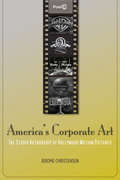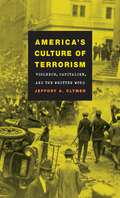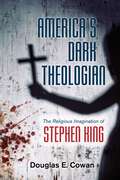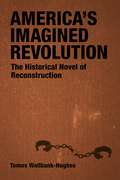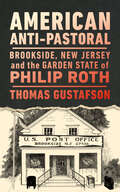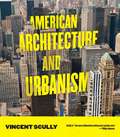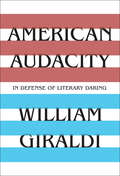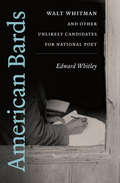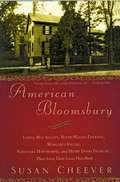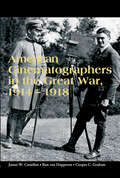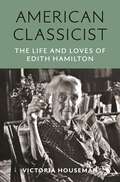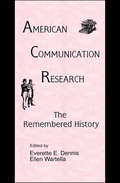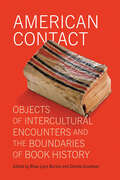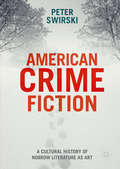- Table View
- List View
America in An Arab Mirror: Images of America in Arabic Travel Literature: An Anthology
by K. Abdel-MalekThis distinguished anthology presents for the first time in English travel essays by Arabic writers who have visited America in the second half of the century. The view of America which emerges from these accounts is at once fascinating and illuminating, but never monolithic. The writers hail from a variety of viewpoints, regions, and backgrounds, so their descriptions of America differently engage and revise Arab pre-conceptions of Americans and the West. The country figures as everything from the unchanging Other, the very antithesis of the Arab self, to the seductive female, to the Other who is both praiseworthy and reprehensible.
America's Asia: Racial Form and American Literature, 1893-1945
by Colleen LyeWhat explains the perception of Asians both as economic exemplars and as threats? America's Asia explores a discursive tradition that affiliates the East with modern efficiency, in contrast to more familiar primitivist forms of Orientalism. Colleen Lye traces the American stereotype of Asians as a "model minority" or a "yellow peril"--two aspects of what she calls "Asiatic racial form"-- to emergent responses to globalization beginning in California in the late nineteenth century, when industrialization proceeded in tandem with the nation's neocolonial expansion beyond its continental frontier. From Progressive efforts to regulate corporate monopoly to New Deal contentions with the crisis of the Great Depression, a particular racial mode of social redress explains why turn-of-the-century radicals and reformers united around Asian exclusion and why Japanese American internment during World War II was a liberal initiative. In Lye's reconstructed archive of Asian American racialization, literary naturalism and its conventions of representing capitalist abstraction provide key historiographical evidence. Arguing for the profound influence of literature on policymaking, America's Asia examines the relationship between Jack London and leading Progressive George Kennan on U.S.-Japan relations, Frank Norris and AFL leader Samuel Gompers on cheap immigrant labor, Pearl S. Buck and journalist Edgar Snow on the Popular Front in China, and John Steinbeck and left intellectual Carey McWilliams on Japanese American internment. Lye's materialist approach to the construction of race succeeds in locating racialization as part of a wider ideological pattern and in distinguishing between its different, and sometimes opposing, historical effects.
America's Birthday
by Vita RichmanThe fun and excitement of English and Language Arts learning continues in Grade 2 of Reading Street. This comprehensive and dynamic curriculum for homeschooling is geared toward young children who have some foundational English and Language Arts knowledge and are ready to strengthen their skills. Comprised of engaging activities, challenging content and weekly quizzes, Reading Street: Grade 2 is the next step in your child's path toward becoming a lifelong learner and reader. As with all Reading Street products, the Grade 2 system is formatted to help students meet certain age-appropriate goals. After completing this English and Language Arts homeschool program, your child should be able to: Read and comprehend two-syllable words. Identify common prefixes (such as pre-, un-, or re-) and suffixes (such as -able, -ad and -er). Correct mistakes made when reading out loud. Read books with two or more chapters. Understand the structure of stores (i. e. beginning, middle and end). Start selecting reading materials based on his/her own interests. Identify the "who," "what," "when," "where," "why" and "how" of the text. While the goals of second Grade English and Language Arts are numerous, Reading Street will help you craft engrossing lessons. Your child will garner important English and Language Arts skills while completing a workbook, reading stories and poems, and taking assessments. Planning these lessons will be easier than ever, as all Reading Street systems are broken down into weekly Big Ideas. All the work your child does on a given week is formulated around that single concept for an organized and challenging curriculum. With six easy-to-follow units, Reading Street: Grade 2 is the perfect tool for homeschooling parents. Your child will enjoy the reading selections and activities, and you'll love to see your student growing into a knowledgeable individual. We're confident that this product is the right one for you. For more information on the specific materials found in Grade 2 of Reading Street, check out the Features and Benefits page.
America's Corporate Art: The Studio Authorship of Hollywood Motion Pictures (1929-2001)
by Jerome ChristensenContrary to theories of single person authorship, America's Corporate Art argues that the corporate studio is the author of Hollywood motion pictures, both during the classical era of the studio system and beyond, when studios became players in global dramas staged by massive entertainment conglomerates. Hollywood movies are examples of a commodity that, until the digital age, was rare: a self-advertising artifact that markets the studio's brand in the very act of consumption. The book covers the history of corporate authorship through the antithetical visions of two of the most dominant Hollywood studios, Warner Bros. and MGM. During the classical era, these studios promoted their brands as competing social visions in strategically significant pictures such as MGM's Singin' in the Rain and Warner's The Fountainhead. Christensen follows the studios' divergent fates as MGM declined into a valuable and portable logo, while Warner Bros. employed Batman, JFK, and You've Got Mail to seal deals that made it the biggest entertainment corporation in the world. The book concludes with an analysis of the Disney-Pixar merger and the first two Toy Story movies in light of the recent judicial extension of constitutional rights of the corporate person.
America's Culture of Terrorism
by Jeffory A. ClymerAlthough the terrorist attacks of 11 September 2001 shocked the world, America has confronted terrorism at home for well over a century. With the invention of dynamite in 1866, Americans began to worry about anonymous acts of mass violence in a way that differed from previous generations' fears of urban riots, slave uprisings, and mob violence. Focusing on the volatile period between the 1886 Haymarket bombing and the 1920 bombing outside J. P. Morgan's Wall Street office, Jeffory Clymer argues that economic and cultural displacements caused by the expansion of industrial capitalism directly influenced evolving ideas about terrorism.In America's Culture of Terrorism, Clymer uncovers the roots of American terrorism and its impact on American identity by exploring the literary works of Henry James, Ida B. Wells, Jack London, Thomas Dixon, and Covington Hall, as well as trial transcripts, media reports, and the cultural rhetoric surrounding terrorist acts of the day. He demonstrates that the rise of mass media and the pressures of the industrial wage-labor economy both fueled the development of terrorism and shaped society's response to it. His analysis not only sheds new light on American literature and culture a century ago but also offers insights into the contemporary understanding of terrorism.
America's Dark Theologian: The Religious Imagination of Stephen King
by Douglas E. CowanIlluminating the religious and existential themes in Stephen King’s horror stories Who are we? Why are we here? Where do we go when we die? For answers to these questions, people often look to religion. But religion is not the only place seekers turn. Myths, legends, and other stories have given us alternative ways to address the fundamental quandaries of existence. Horror stories, in particular, with their focus on questions of violence and mortality, speak urgently to the primal fears embedded in such existential mysteries. With more than fifty novels to his name, and hundreds of millions of copies sold, few writers have spent more time contemplating those fears than Stephen King. Yet despite being one of the most widely read authors of all time, King is woefully understudied. America’s Dark Theologian is the first in-depth investigation into how King treats religion in his horror fiction. Considering works such as Carrie, The Dead Zone, Misery, The Shining, and many more, Douglas Cowan explores the religious imagery, themes, characters, and, most importantly, questions that haunt Stephen King’s horror stories. Religion and its trappings are found throughout King’s fiction, but what Cowan reveals is a writer skeptical of the certainty of religious belief. Describing himself as a “fallen away” Methodist, King is less concerned with providing answers to our questions, than constantly challenging both those who claim to have answers and the answers they proclaim. Whether he is pondering the existence of other worlds, exploring the origins of religious belief and how it is passed on, probing the nature of the religious experience, or contemplating the existence of God, King invites us to question everything we think we know.
America's Imagined Revolution: The Historical Novel of Reconstruction (Southern Literary Studies)
by Tomos Wallbank-HughesAmerica’s Imagined Revolution explores the Reconstruction period after the Civil War to ask narratological, historiographical, and theoretical questions about how slave emancipation has (and has not) been theorized as revolution. Reading historical fiction by authors such as George Washington Cable, Albion Tourgée, Charles Chesnutt, Frances Harper, and W. E. B. Du Bois in dialogue with nineteenth-century historical writing—and the era’s legal, political, and print culture—Tomos Wallbank-Hughes excavates an evanescent form of historicist writing sensitive to the revolutionary changes that shaped life in the emancipation-era South.As an aesthetic form, the historical novel of Reconstruction poses questions about revolutionary experience in plantation societies, and in the process challenges critical assumptions about historical time in the nineteenth century: How do authors narrate epochal change that also feels like retrenchment? In what direction does history travel if it does not progress? What narratives of race, class, and region encompass both continued domination and ruptured power? By plumbing the situations that give it form, the historical novel of Reconstruction provides a window into the literary culture of the South’s long nineteenth century in which, rather than a storehouse of tradition, the region became a terrain for interpreting social revolution and uncovering slavery’s revolutionary afterlives.America’s Imagined Revolution offers a new interpretation of the literary and historiographical significance of the Reconstruction period and its relationship to American literary history.
America's Last Great Newspaper War: The Death of Print in a Two-Tabloid Town
by Mike JaccarinoNAMED A BEST BOOK OF THE WEEK BY THE NEW YORK POSTALSO AVAILABLE AS AN AUDIOBOOKA from-the-trenches view of New York Daily News and New York Post runners and photographers as they stop at nothing to break the story and squash their tabloid arch-rivals.When author Mike Jaccarino was offered a job at the Daily News in 2006, he was asked a single question: “Kid, what are you going to do to help us beat the Post?” That was the year things went sideways at the News, when the New York Post surpassed its nemesis in circulation for the first time in the history of both papers. Tasked with one job—crush the Post—Jaccarino here provides the behind-the-scenes story of how the runners and shooters on both sides would do anything and everything to get the scoop before their opponents.The New York Daily News and the New York Post have long been the Hatfields and McCoys of American media: two warring tabloids in a town big enough for only one of them. As digital news rendered print journalism obsolete, the fight to survive in NYC became an epic, Darwinian battle. In America’s Last Great Newspaper War, Jaccarino exposes the untold story of this tabloid death match of such ferocity and obsession its like has not occurred since Pulitzer– Hearst.Told through the eyes of hungry “runners” (field reporters) and “shooters” (photographers) who would employ phony police lights to overcome traffic, Mike Jaccarino’s memoir unmasks the do-whatever-it-takes era of reporting—where the ends justified the means and nothing was off-limits. His no-holds-barred account describes sneaking into hospitals, months-long stakeouts, infiltrating John Gotti’s crypt, bidding wars for scoops, high-speed car chases with Hillary Clinton, O.J. Simpson, and the baby mama of a philandering congressman—all to get that coveted front-page story.Today, few runners and shooters remain on the street. Their age and exploits are as bygone as the News–Post war and American newspapers, generally. Where armies once battled, often no one is covering the story at all.Funding for this book was provided by: Furthermore: a program of the J. M. Kaplan Fund
America's Mom: The Life, Lessons, and Legacy of Ann Landers
by Rick KoganFor two generations of Americans, reading Ann Landers's daily column was as important as eating breakfast. For nearly fifty years an entire nation turned to this quick-witted, worldly-wise counselor for advice on everything from dinner etiquette to sex. But who was the woman behind the byline?Iowa-born Eppie Lederer was first hired by the Chicago Sun-Times to take over the daily advice column in 1955 -- and over the next half-century she helped shape the nation's social and sexual landscape. Award-winning journalist Rick Kogan was Ann Landers's last editor and close friend, and he paints a fascinating, full-bodied account of the triumphs, the wisdom, the courage, and the trials of one of the twentieth century's most enduring icons -- including her painful lifelong feud with her identical twin sister, "Dear Abby"; her stubborn refusal to shy away from even the most controversial topics; and the tragic breakup of her own thirty-six-year marriage. Filled with remarkable stories shared by people from all walks of life who were profoundly affected by the good sense and guidance of Ann Landers, America's Mom is a moving tribute to a singular woman who has earned an eternal place in our culture ... and our hearts.
American 24-Karat Gold: 24 Classic American Short Stories (4th Edition)
by Yvonne Collioud SiskoThe book presents a selection of 24 classic American short stories. From popular authors such as Mark Twain, Langston Hughes, and Zora Neale Hurston, the stories included in the book become easier to understand with pro-reading questions, vocabulary exercises, and biographical headnotes.
American Abolitionism: Its Direct Political Impact from Colonial Times into Reconstruction (A Nation Divided)
by Stanley HarroldThis ambitious book provides the only systematic examination of the American abolition movement’s direct impacts on antislavery politics from colonial times to the Civil War and after. As opposed to indirect methods such as propaganda, sermons, and speeches at protest meetings, Stanley Harrold focuses on abolitionists’ political tactics—petitioning, lobbying, establishing bonds with sympathetic politicians—and on their disruptions of slavery itself.Harrold begins with the abolition movement’s relationship to politics and government in the northern American colonies and goes on to evaluate its effect in a number of crucial contexts--the U.S. Congress during the 1790s, the Missouri Compromise, the struggle over slavery in Illinois during the 1820s, and abolitionist petitioning of Congress during that same decade. He shows how the rise of "immediate" abolitionism, with its emphasis on moral suasion, did not diminish direct abolitionists’ impact on Congress during the 1830s and 1840s. The book also addresses abolitionists’ direct actions against slavery itself, aiding escaped or kidnapped slaves, which led southern politicians to demand the Fugitive Slave Law of 1850, a major flashpoint of antebellum politics. Finally, Harrold investigates the relationship between abolitionists and the Republican Party through the Civil War and Reconstruction.
American Anti-Pastoral: Brookside, New Jersey and the Garden State of Philip Roth (CERES: Rutgers Studies in History)
by Thomas GustafsonOne of the best-known novels taking place in New Jersey, Philip Roth’s 1997 American Pastoral uses the fictional hamlet of Old Rimrock, NJ as a microcosm for a nation in crisis during the cultural upheavals of the 1960s-70s. Critics have called Old Rimrock mythic, but it is based on a very real place: the small Morris county town of Brookside, New Jersey. American Anti-Pastoral reads the events in Roth’s novel in relation to the history of Brookside and its region. While Roth’s protagonist Seymour “Swede” Levov initially views Old Rimrock as an idyllic paradise within the Garden State, its real-world counterpart has a more complex past in its origins as a small industrial village, as well as a site for the politics of exclusionary zoning and a 1960s anti-war protest at its celebrated 4th of July parade. Literary historian and Brookside native Thomas Gustafson casts Roth’s canonical novel in a fresh light as he studies both Old Rimrock in comparison to Brookside and the novel in relationship to NJ literature, making a case for it as the Great New Jersey novel. For Roth fans and history buffs alike, American Anti-Pastoral peels back the myths about the bucolic Garden State countryside to reveal deep fissures along the fault-lines of race and religion in American democracy.
American Architecture and Urbanism
by Vincent ScullyA classic book authored by the foremost architectural historian in America, this fully illustrated history of American architecture and city planning is based on Vincent Scully's conviction that architecture and city planning are inseparably linked and must therefore be treated together. He defines architecture as a continuing dialogue between generations which creates an environment across time. This definitive survey extends beyond the cities themselves to the American scene as a whole, which has inspired the reasonable balanced, closed and ordered forms, and above all the probity, that he feels typifies American architecture.
American Architecture and Urbanism
by Vincent ScullyA classic book authored by the foremost architectural historian in America, this fully illustrated history of American architecture and city planning is based on Vincent Scully's conviction that architecture and city planning are inseparably linked and must therefore be treated together. He defines architecture as a continuing dialogue between generations which creates an environment across time. This definitive survey extends beyond the cities themselves to the American scene as a whole, which has inspired the reasonable balanced, closed and ordered forms, and above all the probity, that he feels typifies American architecture.
American Audacity: In Defense Of Literary Daring
by William GiraldiOne of the most gifted literary essayists of his generation defends stylistic boldness and intellectual daring in American letters. Over the last decade William Giraldi has established himself as a charismatic and uncompromising literary essayist, “a literature-besotted Midas of prose” (Cynthia Ozick). Now, American Audacity gathers a selection of his most powerful considerations of American writers and themes—a “gorgeous fury of language and sensibility” (Walter Kirn)—including an introductory call to arms for twenty-first-century American literature, and a new appreciation of James Baldwin’s genius for nonfiction. With potent insights into the storied tradition of American letters, and written with a “commitment to the dynamism and dimensions of language,” American Audacity considers giants from the past (Herman Melville, Edgar Allan Poe, Harper Lee, Denis Johnson), some of our most well-known living critics and novelists (Harold Bloom, Stanley Fish, Katie Roiphe, Cormac McCarthy, Allan Gurganus, Elizabeth Spencer), as well as those cultural-literary themes that have concerned Giraldi as an American novelist (bestsellers, the “problem” of Catholic fiction, the art of hate mail, and his viral essay on bibliophilia). Demanding that literature be audacious, and urgent in its convictions, American Audacity is itself an act of intellectual daring, a compendium shot through with Giraldi’s “emboldened and emboldening critical voice” (Sven Birkerts). At a time when literature is threatened by ceaseless electronic bombardment, Giraldi argues that literature “must do what literature has always done: facilitate those silent spaces, remain steadfastly itself in its employment of slowness, interiority, grace, and in its marshaling of aesthetic sophistication and complexity.” American Audacity is ultimately an assertion of intelligence and discernment from a maker of “perfectly paced prose” (The New Yorker), a book that reaffirms the pleasure and wisdom of the deepest literary values.
American Autobiography after 9/11
by Megan BrownIn the wake of the 2001 terrorist attacks in the United States, American memoirists have wrestled with a wide range of anxieties in their books. They cope with financial crises, encounter difference, or confront norms of identity. Megan Brown contends that such best sellers as Cheryl Strayed’s Wild, Elizabeth Gilbert’s Eat, Pray, Love, and Tucker Max’s I Hope They Serve Beer in Hell teach readers how to navigate a confusing, changing world. This lively and theoretically grounded book analyzes twenty-first-century memoirs from Three Cups of Tea to Fun Home, emphasizing the ways in which they reinforce and circulate ideologies, becoming guides or models for living. Brown expands her inquiry beyond books to the autobiographical narratives in reality television and political speeches. She offers a persuasive explanation for the memoir boom: the genre as a response to an era of uncertainty and struggle.
American Bards Walt Whitman and Other Unlikely Candidates for National Poet
by Edward WhitleyWalt Whitman has long been regarded as the quintessential American bard, the poet who best represents all that is distinctive about life in the United States. Whitman himself encouraged this view, but he was also quick to remind his readers that he was an unlikely candidate for the office of national poet, and that his working-class upbringing and radical take on human sexuality often put him at odds with American culture. While American literary history has tended to credit Whitman with having invented the persona of the national outsider as the national bard, Edward Whitley recovers three of Whitman's contemporaries who adopted similar personae: James M. Whitfield, an African American separatist and abolitionist; Eliza R. Snow, a Mormon pioneer and women's leader; and John Rollin Ridge, a Cherokee journalist and Native-rights advocate. These three poets not only provide a counterpoint to the Whitmanian persona of the outsider bard, but they also reframe the criteria by which generations of scholars have characterized Whitman as America's poet. This effort to resituate Whitman's place in American literary history provides an innovative perspective on the most familiar poet of the United States and the culture from which he emerged. Walt Whitman has long been regarded as the quintessential American bard, the poet who best represents all that is distinctive about life in the United States. Whitman himself encouraged this view, but he was also quick to remind his readers that he was an unlikely candidate for the office of national poet, and that his working-class upbringing and radical take on human sexuality often put him at odds with American culture. While American literary history has tended to credit Whitman with having invented the persona of the national outsider as the national bard, Edward Whitley recovers three of Whitman's contemporaries who adopted similar personae: James M. Whitfield, an African American separatist and abolitionist; Eliza R. Snow, a Mormon pioneer and women's leader; and John Rollin Ridge, a Cherokee journalist and Native-rights advocate. These three poets not only provide a counterpoint to the Whitmanian persona of the outsider bard, but they also reframe the criteria by which generations of scholars have characterized Whitman as America's poet. This effort to resituate Whitman's place in American literary history provides an innovative perspective on the most familiar poet of the United States and the culture from which he emerged.
American Bloomsbury
by Susan CheeverEven the most devoted readers of nineteenth-century American literature often assume that the men and women behind the masterpieces were as dull and staid as the era's static daguerreotypes. Susan Cheever's latest work, however, brings new life to the well-known literary personages who produced such cherished works as The Scarlet Letter, Moby-Dick, Walden, and Little Women. Rendering in full color the tumultuous, often scandalous lives of these volatile and vulnerable geniuses, Cheever's dynamic narrative reminds us that, while these literary heroes now seem secure of their spots in the canon, they were once considered avant-garde, bohemian types, at odds with the establishment. These remarkable men and women were so improbably concentrated in placid Concord, Massachusetts, that Henry James referred to the town as the "biggest little place in America." Among the host of luminaries who floated in and out of Concord's "American Bloomsbury" as satellites of the venerable intellect and prodigious fortune of Ralph Waldo Emerson were Henry David Thoreau -- perpetual second to his mentor in both love and career; Louisa May Alcott -- dreamy girl and ambitious spinster; Nathaniel Hawthorne -- dilettante and cad; and Margaret Fuller -- glamorous editor and foreign correspondent. Perhaps inevitably, given the smallness of the place and the idiosyncrasies of its residents, the members of the prestigious circle became both intellectually and romantically entangled: Thoreau serenaded an infatuated Louisa on his flute. Vying with Hawthorne for Fuller's attention, Emerson wrote the fiery feminist love letters while she resided (yards away from his wife) in his guest room. Herman Melville was, according to some, ultimately driven mad by his consuming and unrequited affection for Hawthorne. Far from typically Victorian, this group of intellectuals, like their British Bloomsbury counterparts to whom the title refers, not only questioned established literary forms, but also resisted old moral and social strictures. Thoreau, of course, famously retreated to a plot of land on Walden Pond to escape capitalism, pick berries, and ponder nature. More shocking was the group's ambivalence toward the institution of marriage. Inclined to bend the rules of its bonds, many of its members spent time at the notorious commune, Brook Farm, and because liberal theories could not entirely guarantee against jealousy, the tension of real or imagined infidelities was always near the surface. Susan Cheever reacquaints us with the sexy, subversive side of Concord's nineteenth-century intellectuals, restoring in three dimensions the literary personalities whose work is at the heart of our national history and cultural identity.
American Borders: Inclusion and Exclusion in US Culture (American Literature Readings in the 21st Century)
by Paula Barba Guerrero Mónica Fernández JiménezAmerican Borders: Inclusion and Exclusion in US Culture provides an overview of American culture produced in a range of contexts, from the founding of the nation to the age of globalization and neoliberalism, in order to understand the diverse literary landscapes of the United States from a twenty-first century perspective. The authors confront American exceptionalism, discourses on freedom and democracy, and US foundational narratives by reassessing the literary canon and exploring ethnic literature, culture, and film with a focus on identity and exclusion. Their contributions envision different manifestations of conviviality and estrangement and deconstruct neoliberal slogans, analyzing hospitable inclusion in relation to national history and ideologies. By looking at representations of foreignness and conditional belonging in literature and film from different ethnic traditions, the volume fleshes out a new border dialectic that conveys the heterogeneity of American boundaries beyond the opposition inside/outside.
American Cinematographers in the Great War, 1914–1918
by James W. Castellan Ron van Dopperen Copper C. GrahamA history of American cameramen covering the news of World War I, from the dangerous front line and the risk of execution to red tape and censorship.At the start of hostilities in World War I, when the United States was still neutral, American newsreel companies and newspapers sent a new kind of journalist, the film correspondent, to Europe to record the Great War. These pioneering cameramen, accustomed to carrying the Kodaks and Graflexes of still photography, had to lug cumbersome equipment into the trenches. Facing dangerous conditions on the front, they also risked summary execution as supposed spies while navigating military red tape, censorship, and the business interests of the film and newspaper companies they represented. Based on extensive research in European and American archives, American Cinematographers in the Great War, 1914–1918 follows the adventures of these cameramen as they managed to document and film the atrocities around them in spite of enormous difficulties.“The first book to explore the work and working conditions of American cinematographers active on the different fronts of the First World War. It is a pioneering study which has already attracted a good deal of attention in the academic and archive world.” —Historical Journal of Film, Radio and Television
American Classicist: The Life and Loves of Edith Hamilton
by Victoria HousemanA biography of the remarkable woman whose bestselling Mythology has introduced millions of readers to the classical worldEdith Hamilton (1867–1963) didn’t publish her first book until she was sixty-two. But over the next three decades, this former headmistress would become the twentieth century’s most famous interpreter of the classical world. Today, Hamilton’s Mythology (1942) remains the standard version of ancient tales and sells tens of thousands of copies a year. During the Cold War, her influence even extended to politics, as she argued that postwar America could learn from the fate of Athens after its victory in the Persian Wars. In American Classicist, Victoria Houseman tells the fascinating life story of a remarkable classicist whose ideas were shaped by—and aspired to shape—her times.Hamilton studied Latin and Greek from an early age, earned a BA and MA at Bryn Mawr College, and ran a girls’ prep school for twenty-six years. After retiring, she turned to writing and began a relationship with the pianist and stockbroker Doris Fielding Reid. The two women were partners for more than forty years and entertained journalists, diplomats, and politicians in their Washington, D.C., house. Hamilton traveled extensively around the world, formed friendships with Gertrude Stein and Ezra Pound, and was made an honorary citizen of Athens. While Hamilton believed that the ancient Greeks represented the peak of world civilization, Houseman shows that this suffragist, pacifist, and anti-imperialist was far from an apologist for Western triumphalism.An absorbing narrative of an eventful life, American Classicist reveals how Hamilton’s Greek and Roman worlds held up a mirror to midcentury America even as she strived to convey a timeless beauty that continues to enthrall readers.
American Comics, Literary Theory, and Religion
by A. David LewisUnlocking a new and overdue model for reading comic books, this unique volume explores religious interpretations of popular comic book superheroes such as the Green Lantern and the Hulk. This superhero subgenre offers a hermeneutic for those interested in integrating mutiplicity into religious practices and considerations of the afterlife.
American Communication Research: The Remembered History (Routledge Communication Series)
by Ellen Wartella Everette E. DennisThis book captures the essence of a never-to-be-repeated glimpse at the history of media research. It offers a unique examination of the origins, meaning, and impact of media and communication research in America, with links to European antecedents. Based on a high-level seminar series at Columbia University's Freedom Forum Media Studies Center, the book features work by leading scholars, researchers, and media executives. Participants in the series have called the program "heroic and unprecedented." The book encompasses essays, commentaries, and reports by such leading figures as William McGuire, Elihu Katz, and Leo Bogart, plus posthumous reports by Wilbur Schramm, Malcolm Beville, and Hilde Himmelweit. It also contains original insights on the collaboration of Frank Stanton, Paul Lazarfeld, and Robert K. Merton.
American Contact: Objects of Intercultural Encounters and the Boundaries of Book History (Material Texts)
by Rhae Lynn Barnes and Glenda GoodmanHow studying material texts can help us better understand the diversity of the Americas, past and presentA Hawai’ian quilt stitched with anti-imperial messages; a Jesuit report that captures the last words of a Wendat leader; an invitation to a ball, repurposed by enslaved people in colonial Antigua; a book of poetry printed in a Peruvian penitentiary. Countless material texts—legible artifacts—resulted from the diverse intercultural encounters that characterize the history of the Americas.American Contact explores the dynamics of intercultural encounters through the medium of material texts. The forty-eight short chapters present biographies about objects that range in size from four miles long to seven by ten centimeters; date from millennia in the past to the 2000s; and originate from South America, North America, the Caribbean, and other parts of the Atlantic and Pacific worlds. Each essay demonstrates how particular ways of reading can render the complex meanings of the objects legible—or explains why and how the meanings remain illegible.In its diversity and breadth, this volume shows how the field of book history can be more inclusive and expansive. Taken together, the essays shed new light on the material practices of communicating power and resistance, subjection and survivance, in contact zones of America.Contributors: Carlos Aguirre, Ahmed Idrissi Alami, Chadwick Allen, Rhae Lynn Barnes, Molly H. Bassett, Brian Bockelman, George Aaron Broadwell, Rachel Linnea Brown, Nancy Caronia, Raúl Coronado, Marlena Petra Cravens, Agnieszka Czeblakow, Lori Boornazian Diel, Elizabeth A. Dolan, Alejandra Dubcovsky, Cecily Duffie, Devin Fitzgerald, Glenda Goodman, Rachel B. Gross, David D. Hall, Sonia Hazard, Rachel B. Herrmann, Alex Hidalgo, Abimbola Cole Kai-Lewis, Alexandra Kaloyanides, Rachael Scarborough King, Danielle Knox, Bishop Lawton, Jessica C. Linker, Don James McLaughlin, John Henry Merritt, Gabriell Montgomery, Emily L. Moore, Isadora Moura Mota, Barbara E. Mundy, Santiago Muñoz Arbeláez, Marissa Nicosia, Diane Oliva, Megan E. O’Neil, Sergio Ospina Romero, John H. Pollack, Shari Rabin, Daniel Radus, Nathan Rees, Anne Ricculli, Maria Ryan, Maria Carolina Sintura, Cristina Soriano, Chelsea Stieber, Amy Kuʻuleialoha Stillman, Chris Suh, Mathew R. Swiatlowski, Marie Balsley Taylor, Martin A. Tsang, Germaine Warkentin, Adrian Chastain Weimer, Bethany Wiggin, Xine Yao, Corinna Zeltsman.
American Crime Fiction: A Cultural History of Nobrow Literature as Art
by Peter SwirskiPeter Swirski looks at American crime fiction as an artform that expresses and reflects the social and aesthetic values of its authors and readers. As such he documents the manifold ways in which such authorship and readership are a matter of informed literary choice and not of cultural brainwashing or declining literary standards. Asking, in effect, a series of questions about the nature of genre fiction as art, successive chapters look at American crime writers whose careers throw light on the hazards and rewards of nobrow traffic between popular forms and highbrow aesthetics: Dashiell Hammett, John Grisham, William Faulkner, Ernest Hemingway, Raymond Chandler, Ed McBain, Nelson DeMille, and F. Scott Fitzgerald.



